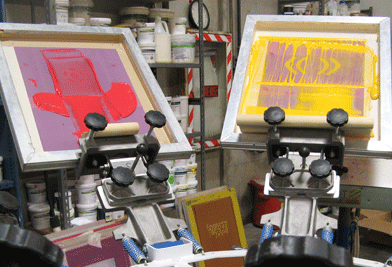New Impressions Article: Top 5 Necessities for Screen Printing Press
October 07, 2011
 Kieth Stevens, our Western Regional Sales Manager, just had another article published on Impression Magazine's online site. In this article, he is focusing on the top 5 items that a screen printer should have handy at the screen printing press.
Here is a copy of the article:
Kieth Stevens, our Western Regional Sales Manager, just had another article published on Impression Magazine's online site. In this article, he is focusing on the top 5 items that a screen printer should have handy at the screen printing press.
Here is a copy of the article:
Top 5 Necessities For Your Screen Printing Press
October 04, 2011By Kieth Stevens, Contributing Writer
As a screen printer, ensuring that you deliver top-quality prints in a timely manner goes far beyond the kind of press or inks you use. Much like anything else, the smallest details — proper tools or tapes — can end up making a big difference in the results for you and your customer. Every screen printer should have a list of basics needed to accomplish any job, no matter how big or small. Following is a list of five essentials that screen printers should keep handy at their presses. 1. Pallet Adhesive — This pressure-sensitive adhesive is designed for adhering textiles to printing pallets during the screen printing process. There are generally two types of pallet adhesives: solvent-based and water-based. There are a couple of solvent-based adhesive types, the first of which usually comes in a spray can with two types of nozzles — a fine mist and a web type. Both are tacky and designed to hold the garments to the pallet securely, but the web type generally is better for adhering heavier fabrics, such as sweat shirt material, to the pallet. The other solvent-based adhesive holds up better under the elevated heat generated by flash-cure units. This type of adhesive withstands the higher heat without affecting the fabric. The water-based adhesive often is sold in buckets and usually is applied using a squeeze bottle, and then spread out to quickly dry on the pallet. This type is considered to be less harmful to the environment, equipment and to humans. It also may be more economical than the solvent-based spray type. A single application — once it is coated with lint — can be reactivated by dabbing it with a damp cloth. 2. Pallet Tape — Screen printers previously had to clean their pallets with solvents to remove residues that accumulated during the printing process. The build-up, mainly caused by excessive squeegee pressure, adhesive and lint from thousands of shirts, would start to downgrade the print quality. This meant the cleaning process would take hours, and was very messy and unhealthy because of the fumes to which screen printers were exposed. Today, printers can use a repositionable paper called pallet tape, which can be peeled away with all that buildup and tossed away. The pallet tape protects the print pallet from ink stains and spillage, and replacing it is easy. 3. Proper Tools — As a former race car driver, I know the importance of “the right tool for the job.” For example, I cringe when I see adjustable wrenches being used on expensive automatic printing machines. After years of continual adjustments without using the proper tools, the nuts and bolts that are used to adjust levels, heights, etc. on an automatic screen printing press most surely will be rounded, thus needing replacement. Printers often neglect to adjust anything on automatic presses because they find it too difficult to do adjustments without having the right tools. The resulting print quality will not be optimal and the machine’s lifespan also may be shortened. Invest in the right tools for the job! 4. Tape — There are a lot of inexpensive tapes being used to block out the edges of the screen and for on-the-press pinhole repairs, but beware: When it comes to tape, you get what you pay for. Cheap tapes often will leave glue residue that must be removed before a screen can be reclaimed. This residue can get everywhere: on floors, sinks, hands, etc. By saving money on a cheap roll of tape, you could be losing hours in production time. My advice is to consult your suppliers about which tapes they recommend and do some comparisons. 5. Ink-Handling Tools For The Press — Everyone in a medium- to high-production shop needs to use something to handle the ink in the screen as it is being consumed on long production runs. Many shops use a square piece of cardboard, which can work for the short term. But I have been in shops that print jobs with more than 200,000 shirts, and cardboard is not the best tool to use in such conditions. Why? Cardboard soaks up the oils in the ink, which can affect its viscosity (stiffness). Often, the cardboard gets left in the ink container, which contaminates the entire bucket. I recommend using plastic spreaders instead — the kind often used in automotive body shops. These handy plastic spreaders are readily available, are soft and pliable, and won’t rip a screen or soak up anything. (These spreaders also are used to apply graphics to vehicles.) Check with your local distributor for what they offer. Kieth Stevens is the Western regional sales manager for International Coatings. He has been teaching screen printing for more than 10 years and is a regular contributor to International Coatings' blogs. For more information, visit iccink.com and read the company’s blog at internationalcoatingsblog.com. International Coatings manufactures a complete line of screen printing inks, including a wide variety of whites, specialty inks, special effects inks, color matching systems, additives and reducers. For more information on our products, please visit our website at www.iccink.com.
 International Coatings: Is Everywhere You Want To Be
International Coatings: Is Everywhere You Want To Be


